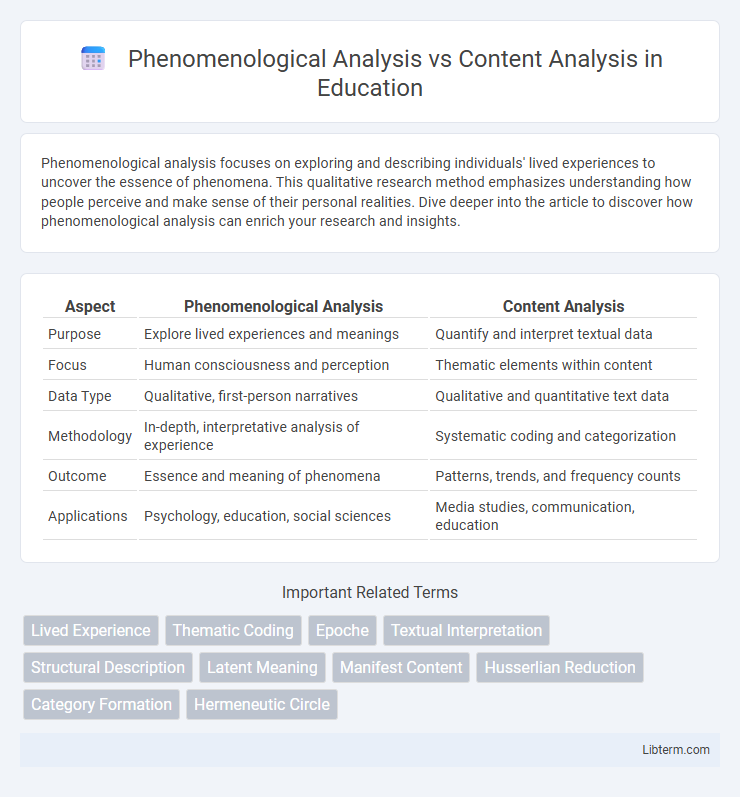Phenomenological analysis focuses on exploring and describing individuals' lived experiences to uncover the essence of phenomena. This qualitative research method emphasizes understanding how people perceive and make sense of their personal realities. Dive deeper into the article to discover how phenomenological analysis can enrich your research and insights.
Table of Comparison
| Aspect | Phenomenological Analysis | Content Analysis |
|---|---|---|
| Purpose | Explore lived experiences and meanings | Quantify and interpret textual data |
| Focus | Human consciousness and perception | Thematic elements within content |
| Data Type | Qualitative, first-person narratives | Qualitative and quantitative text data |
| Methodology | In-depth, interpretative analysis of experience | Systematic coding and categorization |
| Outcome | Essence and meaning of phenomena | Patterns, trends, and frequency counts |
| Applications | Psychology, education, social sciences | Media studies, communication, education |
Introduction to Phenomenological Analysis and Content Analysis
Phenomenological Analysis explores individuals' lived experiences to uncover the essence of phenomena through in-depth, subjective interpretation of qualitative data. Content Analysis systematically categorizes and quantifies textual or visual information to identify patterns, themes, and frequencies within large datasets. Both methodologies provide critical insights in qualitative research, with Phenomenological Analysis focusing on meaning and perception, while Content Analysis emphasizes data structure and occurrence.
Defining Phenomenological Analysis
Phenomenological analysis is a qualitative research method focused on exploring and describing individuals' lived experiences to uncover the essence and meaning of phenomena. It emphasizes understanding participants' subjective perceptions and emotions through in-depth interviews and thematic interpretation. This approach contrasts with content analysis, which systematically categorizes textual data to identify patterns and frequencies without prioritizing personal experience.
Defining Content Analysis
Content analysis is a systematic research method used to interpret textual, visual, or audio data by categorizing and quantifying patterns, themes, or messages within the content. It enables researchers to objectively analyze large volumes of communication by coding data into predefined or emergent categories for statistical or thematic examination. This method contrasts with phenomenological analysis, which seeks to understand participants' lived experiences, focusing on subjective meaning rather than objective content categorization.
Core Philosophical Foundations
Phenomenological analysis is grounded in the philosophy of phenomenology, emphasizing the lived experiences and consciousness of individuals to uncover the essence of phenomena. Content analysis is rooted in positivist and post-positivist traditions, focusing on systematically quantifying and categorizing textual data to identify patterns and meanings. The core philosophical distinction lies in phenomenology's aim to interpret subjective experience, while content analysis prioritizes objective, measurable content evaluation.
Key Methodological Differences
Phenomenological analysis emphasizes exploring individuals' lived experiences by interpreting the essence of their subjective consciousness, utilizing in-depth interviews and reflective descriptions. Content analysis systematically categorizes and quantifies textual data to identify patterns, themes, or frequencies, often employing coding schemes and statistical methods. Unlike content analysis, phenomenological analysis prioritizes understanding meaning and context over merely categorizing data.
Data Collection Approaches
Phenomenological analysis collects data primarily through in-depth, open-ended interviews to explore participants' lived experiences and capture their subjective perspectives. Content analysis employs systematic coding of textual, visual, or audio data from diverse sources like documents, media, or transcripts to identify patterns, themes, or frequencies. While phenomenological approaches prioritize rich, descriptive narratives, content analysis emphasizes quantifiable and replicable categorization of data units.
Data Interpretation Techniques
Phenomenological analysis interprets data by exploring participants' lived experiences and the essence of phenomena through in-depth thematic examination. Content analysis quantifies and categorizes textual data to identify patterns and frequency of themes or concepts systematically. Both techniques employ coding strategies, but phenomenological analysis emphasizes subjective meaning, whereas content analysis focuses on objective data classification.
Applications in Research Fields
Phenomenological analysis is extensively applied in psychology and nursing research to explore individuals' lived experiences and subjective perceptions, providing in-depth insights into human consciousness and meaning-making. In contrast, content analysis is widely used in communication studies, marketing, and social sciences to systematically quantify and interpret textual or multimedia data for identifying patterns, themes, and trends across large datasets. Both methodologies offer rigorous tools for qualitative research but cater to distinct objectives: phenomenological analysis emphasizes understanding essence and experience, whereas content analysis focuses on categorization and frequency of content elements.
Strengths and Limitations of Each Method
Phenomenological analysis excels at capturing the depth of lived experiences and uncovering underlying meanings, offering rich, detailed insights into subjective perceptions, but it can be time-consuming and reliant on participants' verbal articulation. Content analysis systematically quantifies patterns and frequencies within textual data, providing objective, replicable results applicable to large datasets, yet it may overlook nuanced contextual meanings and depth in favor of categorization. Both methods complement each other by balancing the richness of qualitative depth with structured, measurable data interpretation.
Choosing the Right Analysis for Your Study
Phenomenological analysis emphasizes exploring lived experiences to uncover deep meanings and subjective realities, making it ideal for studies focused on personal perception and consciousness. Content analysis quantitatively categorizes textual data to identify patterns, frequencies, and themes, fitting research aimed at objectively analyzing communication content across large datasets. Selecting the right analysis depends on whether your study prioritizes in-depth understanding of individual experiences or systematic, replicable categorization of textual information.
Phenomenological Analysis Infographic

 libterm.com
libterm.com